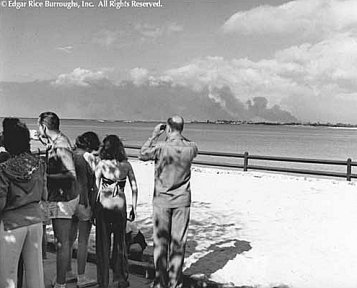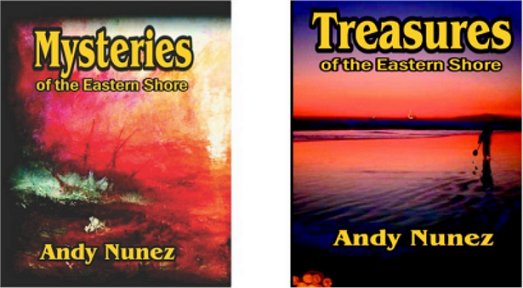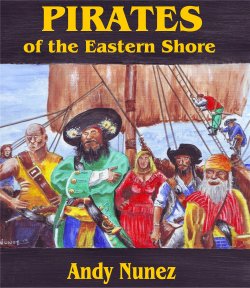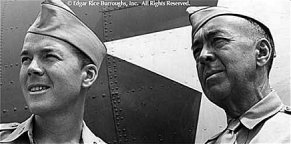The Whiff of Grapeshot
From Against The Odds
No. 43
 War
is never static, yet our most memorable images of war are photos.
As our publisher knows my fondness for all things Edgar Rice Burroughs,
he ran across a photo of the creator of Tarzan watching the attack on Pearl
Harbor. For those who don’t know ERB, as he is popularly known, was
the son of a Union major, serving with Phil Sheridan in the waning years
of the Civil War. ERB was born in 1875 and attended Michigan Military
Academy. After graduation, he ended up in the Seventh Cavalry out
West, fighting the Indians. During World War I he became a major
in the Illinois Reserve Militia and wrote fervently of patriotism.
War
is never static, yet our most memorable images of war are photos.
As our publisher knows my fondness for all things Edgar Rice Burroughs,
he ran across a photo of the creator of Tarzan watching the attack on Pearl
Harbor. For those who don’t know ERB, as he is popularly known, was
the son of a Union major, serving with Phil Sheridan in the waning years
of the Civil War. ERB was born in 1875 and attended Michigan Military
Academy. After graduation, he ended up in the Seventh Cavalry out
West, fighting the Indians. During World War I he became a major
in the Illinois Reserve Militia and wrote fervently of patriotism.
All this background, along with rigorous exercise like horseback
riding and playing tennis with the likes of Ralph Bellamy and Jimmy Cagney,
came in handy when Ed moved to Hawaii in the late 1930s with his second
wife, Florence. On a certain Sunday morning, December 7, 1941, Ed
and his son Hulbert got up early to play tennis and heard the distinct
sound of guns firing in the distance. At first thinking it was a
drill, Ed and Hulbert had breakfast and played tennis, but realized it
was no drill when an enemy plane went after a cargo ship only a mile from
their position. Grabbing some binoculars, Ed saw for himself what
was happening.
As brave as the characters he created, Ed, his son, and some friends,
volunteered to do their part in the defense of the island. He was
sixty-six, but grabbed a Springfield and helped guard important facilities
and interned Japanese. Sore and exhausted, Ed recounted his exploits
and the many rumors that abounded that day. Enraged at the Japanese
actions, but grudgingly admiring their efficiency (he referred to it as
“German”), Ed decided to write a series of columns to whip up patriotism,
and with the crumbling of his second marriage, became the oldest war correspondent
in World War II, travelling all over the Pacific.
Initially scorning the Japanese as sub-human and cruel (just read
his novel Tarzan and the Foreign Legion), somewhere in the
war he felt sympathetic toward the parents of those Japanese who were honorably
serving in the US Armed Forces and spoke out against planned deportations.
His many interviews with soldiers and his witnessing Japanese prisoners
first hand softened his anger as the war dragged on, and by its end, he
was tired, physically exhausted, and went back to California to spend the
remaining five years of his life.
 His
thought patterns reflect the US mood at the start of the war: anger
at Pearl Harbor, defiance at Wake Island, and the realization of the grim
task ahead that led to our second game in this issue, Peleliu. After
the horrors of the atomic bomb, we paused to wonder if the awful mushroom
clouds were the end of just one war, or a prophecy of the future.
His
thought patterns reflect the US mood at the start of the war: anger
at Pearl Harbor, defiance at Wake Island, and the realization of the grim
task ahead that led to our second game in this issue, Peleliu. After
the horrors of the atomic bomb, we paused to wonder if the awful mushroom
clouds were the end of just one war, or a prophecy of the future.
The clash between Japan and the Western Allies slowly built as
the Japanese felt a ring was tightening around them, exacerbated by the
Washington Naval Treaty. Tensions rose during the Japanese occupation
of Manchuria, when the US put economic sanctions in place. The final
straw for Japan was in July 1940. After the defeat and occupation
of France and Holland by the Nazis, Japan took advantage of the situation
to grab French Indochina. The US and Britain froze Japanese assets
and placed an embargo on petroleum product sales to Japan.
Faced with economic disaster and a stranglehold on the lifeblood of
the Japanese war machine, the Japanese took the path to war. Both
sides commited horrific acts in the struggle for dominance in the Pacific,
including using nuclear weapons, an act seen both as barbarous and merciful
since it staved off a long and savage invasion of the Japanese home islands
and allowed a peace with the West that remains in place today.
I pondered if the world were heading down a similar path with
Russia. The Russians were as opportunistic this spring as were the
Japanese back then, seeing Ukraine as their sphere of influence.
The West disagreed and a round of sanctions ensued. Last night, the
parallel was so on my mind that I dreamed that I personally met with Putin
to try to iron out the situation. He seemed amenable enough, then
his secretary tried to seduce me. Sadly she failed (I now know I
must be getting old), so I realized he was just playing for time and woke
up.
Back to reality, though: I would like to thank the nice folks
at Casemate Publishing for an advance copy of No Turning Back, A Guide
to the 1864 Overland Campaign by Robert Dunkerly, Donald Pfanz and
David Ruth. Also thanks to the happy crew at Osprey for another armload
of titles, including Hitler’s Blitzkrieg Enemies, Operation Flipper,
Lincoln's 90-Day Volunteers 1861: From Fort Sumter to First Bull Run,
and The Shenandoah Valley 1862. Winners all, though I might
be a bit prejudiced since they are publishing my latest book on the Wilderness
and Shenandoah.
For now, though, it’s across the blue Pacific and into the green,
volcanic hells of Wake and Peleliu, where every bullet counts and surprises
lay around every corner. Join the Old Breed and come to grips with
the Imperial Forces. Whether the hunter or the hunted, the Marines’
time has come to show that, even against the odds, they are “always faithful”.


 .
.
![]()


![]()
![]()

![]()